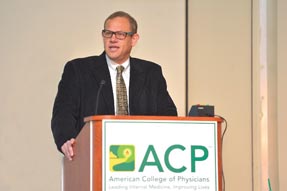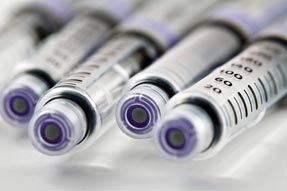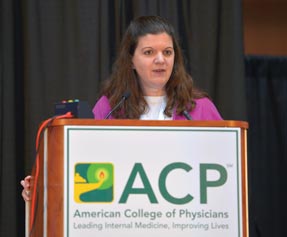Pearls for lowering lipids
New guidelines recommend basing treatment decisions on levels of risk rather than LDL targets.
Internists often treat patients with dyslipidemia and hyperlipidemia, but some familiarity with these conditions may have dissipated after the American Heart Association and the American College of Cardiology (AHA/ACC) changed their guidelines about using lipid-lowering therapy to reduce cardiovascular risks, said Leonard Mankin, MD, FACP.
Of note, the randomized controlled trials considered in the guidelines did not titrate treatment doses to levels of LDL and instead looked at statins versus placebo and high versus low doses of statins. In the trials, patients at the highest risk for atherosclerotic cardiovascular disease events (acute coronary syndrome, myocardial infarction, stroke, angina, peripheral artery disease, or coronary revascularization) gained the most benefit from therapy.

For this reason, the panel decided to get rid of LDL targets and recommend that clinicians base treatment decisions on levels of risk, said Dr. Mankin, associate program director at Legacy Health in Portland, Ore., and associate professor of medicine at Oregon Health & Science University. “The moment the guidelines hit the press... many physicians felt uncomfortable,” he said.
To ease the discomfort surrounding the new guidelines, Dr. Mankin explained the ins and outs of statin therapy during the “Advances in Therapy” pre-course at Internal Medicine Meeting 2016.
LDL is a viable correlate of coronary heart disease risk, and risk of ischemic heart disease is reduced by 20%, 31%, and 51% when LDL is lowered by 20 mg/dL, 40 mg/dL, and 62 mg/dL, respectively, Dr. Mankin noted. Additionally, in studies of high- versus low-intensity statins, each case produced a significant reduction in LDL and major cardiovascular events. “It's all seeming very clear that we need to go back to LDL targets, but wait—it's not always that simple,” he said, noting that in 1 study of LDL reduction with nonstatins, LDL reduction was met with an increase in cardiovascular outcomes. “So it may not be all LDL—is it absolute LDL value or degree of reduction?” Dr. Mankin said.
Cardiovascular event rates are much lower if a patient's LDL is reduced by 50% or more as compared to patients close to or already at target LDL levels less than 70 mg/dL, he added. Although the guidelines no longer recommend treating to target LDL goals, Dr. Mankin recommended keeping a keen eye on LDL response. “It appears to be the percent LDL reduction that is the most important element,” he said.
According to the guidelines, the 4 target groups that should receive statin therapy are:
- patients with known atherosclerotic cardiovascular disease,
- patients with diabetes who are ages 40 to 75 with an LDL greater than or equal to 70 mg/dL,
- those with an LDL greater than or equal to 190 mg/dL, and
- those ages 40 to 75 with no atherosclerotic cardiovascular disease or diabetes, with an LDL between 70 and 189 mg/dL, and a 10-year atherosclerotic cardiovascular disease risk greater than or equal to 7.5%.
For this final measure, the AHA and ACC provided a new risk calculator, which estimates that nearly one-third of the U.S. population would now be eligible for statin therapy. But this calculator's accuracy has been questioned and must be studied further, Dr. Mankin said.
To treat dyslipidemia, internists should first consider therapeutic lifestyle modifications, such as diet, exercise, smoking cessation, and maintenance of a normal body mass index, he said. In addition, the 2015 U.S. dietary guidelines have eliminated specific limits on dietary cholesterol, as it doesn't affect serum cholesterol very much, so “The egg has been freed,” Dr. Mankin said.
But when lifestyle modifications are not possible, “Statins are king,” he said. They decrease mortality in primary and secondary prevention, as well as lower the risks of myocardial infarction, stroke, and revascularization procedures, he said. Regarding the efficacy and pricing of the statins themselves, atorvastatin appears to provide “the most bang for your buck,” at $15 to $20, Dr. Mankin added.
Potential complications of statins include an increased, dose-dependent risk of diabetes, he said. “This is why statins have not gone over the counter.” Put in the context of every 255 patients over the course of 4 years, this risk translates into 1 new case of diabetes and 5.4 prevented vascular events, Dr. Mankin added. Another potential complication is elevation of liver enzymes, which is usually minor and reversible, he noted.
Although some patients may be intolerant to statins, data from randomized controlled trials suggest that more than 90% of patients who had an adverse event from a statin can tolerate its reintroduction, he added. “If the patient cannot tolerate a statin, reintroduce a statin. ... Statin intolerance is way overdiagnosed.” In situations of statin intolerance, internists should change the statin or reduce dosing, as many patients will be willing to take the drug once a week, Dr. Mankin said.
In terms of nonstatin therapies, newcomers alirocumab and evolocumab, which belong to the PCSK9 inhibitor class, gained FDA approval in summer 2015. Given subcutaneously about every 2 weeks, these drugs are approved for patients with familial hyperlipidemia, patients intolerant to statins, and patients with high cardiovascular risk who are unable to reach their LDL goals with maximal statins. Because the yearly cost of these drugs is roughly $13,000 and there are limited data on outcomes, Dr. Mankin said their use should be limited to patients with familial hyperlipidemia.
In addition, internists should consider ezetimibe in the highest-risk patients with an LDL level greater than 70 mg/dL who are either statin intolerant or on a maximum dose of a statin. The drug is typically well tolerated, and a generic form is due out at the end of the year, Dr. Mankin said.
Nonstatin drugs that are of unlikely benefit are niacin and fenofibrate, which have shown no benefits in lowering cardiovascular events, he added. In regard to fish oil, a review of 20 randomized controlled trials found no cardiovascular benefits, Dr. Mankin said. “Fish oil is a low-risk intervention with uncertain benefits,” he said. “We need to weigh risks and benefits.”





